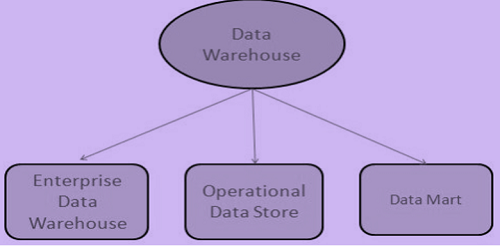Home »
Data Warehouse
What is Data Warehouse? Definition, Types & Example
In this tutorial, we are going to learn about the data warehouse, how it works and its different types.
Submitted by IncludeHelp, on January 06, 2021
Data Warehouse
In 1990, Bill Inmon first coined the term "Data Warehouse". Inmon has data warehouse as – "a data warehouse is a subject-oriented, integrated, time-variant, and non-volatile data collection. This information helps analysts in an organization to make informed decisions".
The data warehouse is the place where information is stored and used before it is analyzed. The process of aggregating data from different database sources into one place for efficient access and analysis also includes data warehousing. The architecture of the data is another aspect of data warehousing, i.e., it is structured in such a way that it can be joined, even if the sources have different fields and patterns. Data warehousing is a key strategic differentiator in today's global marketplace as a record of a company's past operational and transactional information, particularly given the proliferation of data sources, volume, and density.
How does Data Warehouse work?
A Data Warehouse acts as a central repository where one or more data sources obtain information. Data flows from the transactional system and other relational databases into a data warehouse.
Data may be Structured, Semi-structured, and Unstructured data.
The information is processed, transformed, and ingested so that, through Business Intelligence tools, SQL clients, and spreadsheets, users can access the processed data in the Data Warehouse. In one comprehensive database, the data warehouse merges information from various sources. Organizations can analyze their clients more holistically by combining all of this information in one place. This helps to ensure that all the available information has been considered. Data warehousing makes it possible for data mining. Data mining looks for data patterns that can lead to higher revenues and profits.
Data Warehouse Types
There are the types of Data warehouse which are described as follows -
1) Enterprise Data Warehouse (EDW)
A centralised warehouse is the Enterprise Data Warehouse (EDW). It provides enterprise-wide decision support services. It offers a unified strategy for data organization and representation. It also provides the ability to classify and give access to data by topic according to those divisions.
2) ODS (Operational Data Store)
This has a wide enterprise scope, but data is refreshed in near real-time and used for routine business activity, unlike the actual enterprise data warehouse.
3) Data Mart
A data mart is a data warehouse subset that is intended for specific business instances such as sales, marketing, or finance. Data can be derived from an enterprise-wide data warehouse in a dependent data mart. Data can be collected directly from sources in an independent data-mart.

Evolution in Organization use of these terms refer to the level of sophistication of a data warehouse.
The following are general stages of data warehouse (DWH) usage
- Offline Operational Database - In this stage of evolution, data warehouses from operating systems are updated on a regular time cycle (usually daily, weekly or monthly) and the data is stored in an integrated reporting-oriented database.
- Offline Data Warehouse - Data is regularly updated from the Operational Database in the Data warehouse. To fulfil the goals of Data warehouse, the data in Data warehouse is mapped and transformed.
- Real-time Data Warehouse - Data warehouses are updated at this stage whenever any transaction occurs in the operational database. The airline or railway booking system, for instance.
- Integrated Data Warehouse - These data centers gather data from various areas of business so that users can search for the information they need through other systems.
Advertisement
Advertisement